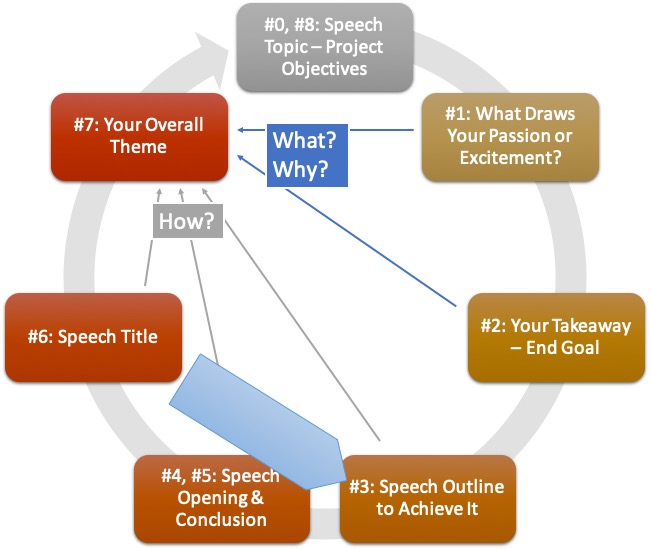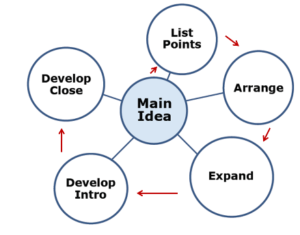How do you prepare for your speech presentation? What can you do to have a clear direction for your message?
A CLEAR IDEA: TWO OBJECTIVES
This tool is organized with two objectives in mind:
- What is your main idea with this speech presentation? Make it clear to yourself.
- Once it is clear to you, your presentation’s goal should be to create that idea in your audience’s minds. What would it take so that your audience will get your picture? What would it take for your audience to see it from your perspective?
Chris Anderson, Head of TED, has described it so powerfully in this video:
We want to consider it in the context of speech presentations we prepare and deliver at our Toastmasters meetings.
STEPS FOR PUTTING TOGETHER YOUR SPEECH

STEP # 0: SPEECH TOPIC – PROJECT OBJECTIVES
Think about your speech project objectives and how a particular topic can help you achieve them.
See more about speech topic selection in this article (Click this link).
Write down how the topic can help you with the project objectives in a sentence or two. If you need help coming up with speech topics, ask coaches.
STEP # 1: YOUR EXCITEMENT FOR THE SPEECH TOPIC
- What prompted you to select this as my speech topic?
- What do you like about it?
- What makes you think about it?
Answer it in one or two sentences. The idea is to keep the passion or excitement behind the speech topic in mind while preparing for the presentation. Think about it and write down your first cut at the answer as you start the process; it will help you.
If a different answer emerges for you while preparing for the speech, revise it.
STEP # 2: TAKE AWAY FROM THE PRESENTATION
What is your key takeaway from this presentation? Or, what is the main idea of this speech? Answer it by completing one of the following two sentences.
- I want my audience to
- I want to
Examples:
- I want my audience to understand how nanotechnology is impacting our lives.
- I want to explain how nanotechnology is impacting our lives.
- I want to inspire my audience to learn more about nanotechnology.
- I want my audience to see how my vacation trips help me understand different cultures and ways of life.
- I want my audience to appreciate the thrill I had from different places I visited.
- I want to show how I enjoy spending time with my family on vacation trips.
- I want my audience to understand the importance of maintaining good posture.
- I want to describe how basketball is making a difference for me.
- I want to share what earning the 3rd-degree black belt test at Tae Kwon Do means.
- I want to inspire my audience to join the Boy Scouts (or the Girls Scouts).
- I want my audience to see how the Boy Scouts can help them become better leaders.
- I want to show how I enjoy playing video games.
- I want my audience to understand how video games positively impact youth.
Note: The examples in the above list – #2 & #3, or #4, #5 & #6, or #10 & #11, or #12 & #13 – are related but have a different message, and so would be very different speech presentations.
STEP # 3: OUTLINE FOR YOUR SPEECH

Please start with your presentation’s main idea or takeaway (step # 2), and develop a speech organization to help you achieve it. Creating your speech outline should be an iterative process. Brainstorm, compile your ideas, and group them in points – after that, revisit the process to refine the overall design.
A speech outline should look like this when you complete the process:
Part I – Opening
- Begin with something that will capture the interest and attention of the audience.
- Introduce your topic.
- Develop a brief statement to transition into what you will discuss next.
Part II – Main Body
- Main point 1 – transition
- Main point 2 – transition
- Main point 3 – transition
Part III – Conclusion
- Recap your message or the theme.
- Close with impact.
Again, developing your speech outline can be an iterative process. Feel free to go back and revise it while you prepare and practice.
STEP # 4: SPEECH OPENING
Try your speech opening out loud; feel it. Revise it in the process so it flows naturally for you. Practice it at least a few times. Bring energy and enthusiasm with your speech opening.
Action Item: If you need to revise the speech theme or outline while practicing the speech opening aloud, do so. Practice presenting your speech opening at least three times, and use our engagement techniques (more on it is in this link – click on it.)
STEP # 5: SPEECH CONCLUSION OR ENDING
Please think of how this topic can relate to people in your audience personally, or what they can use it somehow for themselves, or a lasting impression you would like to leave so that they will remember your speech.
Try your conclusion out loud; feel it. Revise it in the process so it flows naturally for you. Practice it at least a few times.
Action Item: If you need to change the speech outline while practicing the opening and conclusion, that is okay and recommended. Speech preparation is an iterative process.
STEP # 6: SPEECH TITLE
Questions or ideas to Consider to select your speech title:
- Avoid giving away your speech with the title. You want your audience to listen to your presentation to see what it is. A speech title, in that regard, can be very different from the title of a written essay or a book. Using the title to summarize what is in the article for a written piece probably makes sense. A speech title, on the other hand, can be a tool to intrigue your audience.
- The title could be the word(s) for a key idea or theme you develop in your speech.
- The title could be the surprise element or a climax you develop in your speech.
- Maybe, weave in the title in your conclusion.
- What is a critical idea for the audience to understand your perspective? Make it your speech title.
- Tie in the title to your crucial takeaway for them. It will help you reinforce your purpose for the speech; it can help you drive the point home.
Action Item: Write down your idea and angle for the speech title. What is your speech title and your thought process to decide on it?
STEP # 7: YOUR OVERALL THEME WITH THE PRESENTATION
- Think about steps #1 and #2 one more time. What excited you about this speech topic? What is your intended takeaway from it?
- Do steps #3, #4, #5, and #6 help you achieve your speech objectives? Revise them as required.
- Make sure to make it clear and explicit where you are going with your speech title. If your audience couldn’t understand your speech title’s meaning from your presentation, you missed an opportunity to make a strong connection and make your message memorable.
Split your preparation over multiple days; clarifying your theme and message will work wonders.
Action Item: Write your theme in one or two sentences in this step.
STEP # 8: PROJECT OBJECTIVES (AGAIN 😄)
Think about your speech objectives one more time. Practice.
For example:
- If it is about using body language, consider when, where, and how you can integrate it into your delivery.
- If it is about developing vocal variety, practice emphasizing keywords using the “stretch” technique, delivery of dialogs in your speech, variation in tonality, use of pauses, change in projection, etc.
- If it is about persuading or inspiring your audience, practice emotional engagement and bringing out your connection to or passion for the speech topic.
- If it is about using descriptive language, prepare and practice vivid descriptions, metaphors, similes, rhetorical devices, etc.
Action Item: Share in 3-5 sentences your plan to implement ideas for the project objectives.
VIDEO RECAP OF EIGHT STEPS
The following video recaps the eight steps that I described in this speech preparation tool/framework.
NOTE ON VISUAL AIDS
- Have a clear plan for how you think the visual aid will support your idea. Why and how will a visual aid add value? It will probably complicate your life and dilute your presentation if you can’t clearly explain why you need it.
- PowerPoint or Keynote slides presentation isn’t the only visual aid option. Bring a project you might have worked on if the speech concerns that. Use an easel with a chart and write/draw/develop it as you speak, like a classroom chalk talk. Bring something printed for everyone in the audience, so they can see and follow it when you talk.
- Q: “What if I use slides to list my main points to develop?”
A: I’d use it only if you think it will help you reinforce your message for them. If you use visual slides to remind yourself what is next, a much easier and simpler thing is to bring small handwritten flashcards. It will probably save you time and effort. It will also help you focus on your delivery. - When you use PowerPoint or Keynote, remember that you are the presenter, not the TV screen. TV and your slides are tools to help you, not replace you. Avoid reading word for word what is on your visuals. Or else your audience can get bored.
